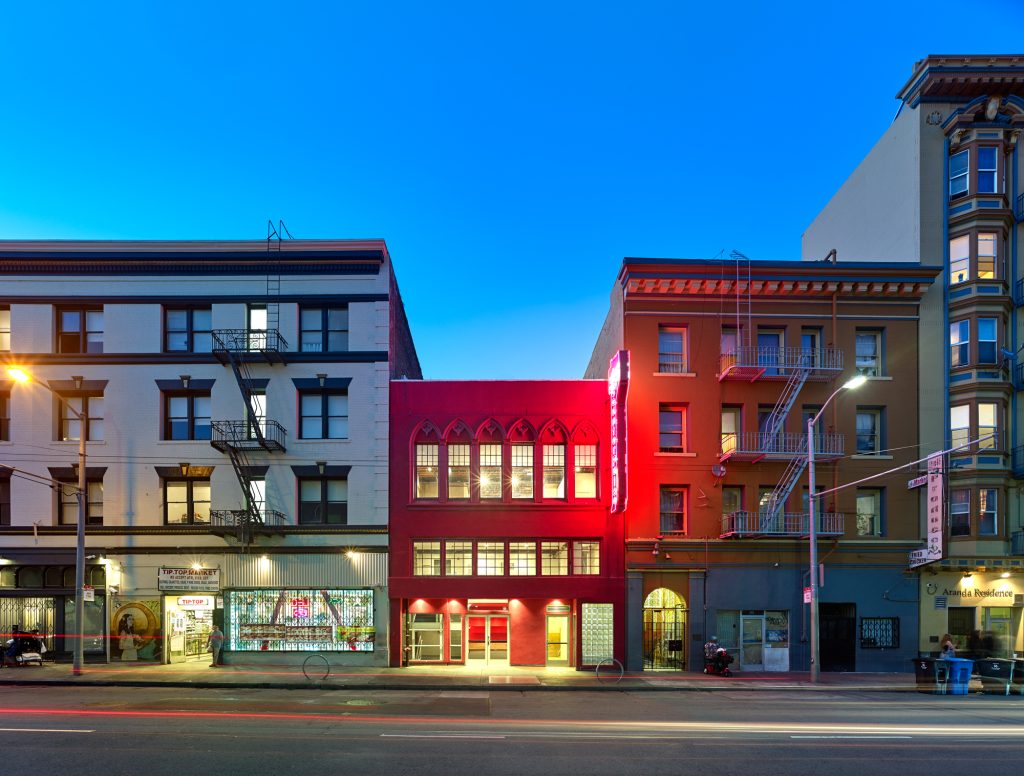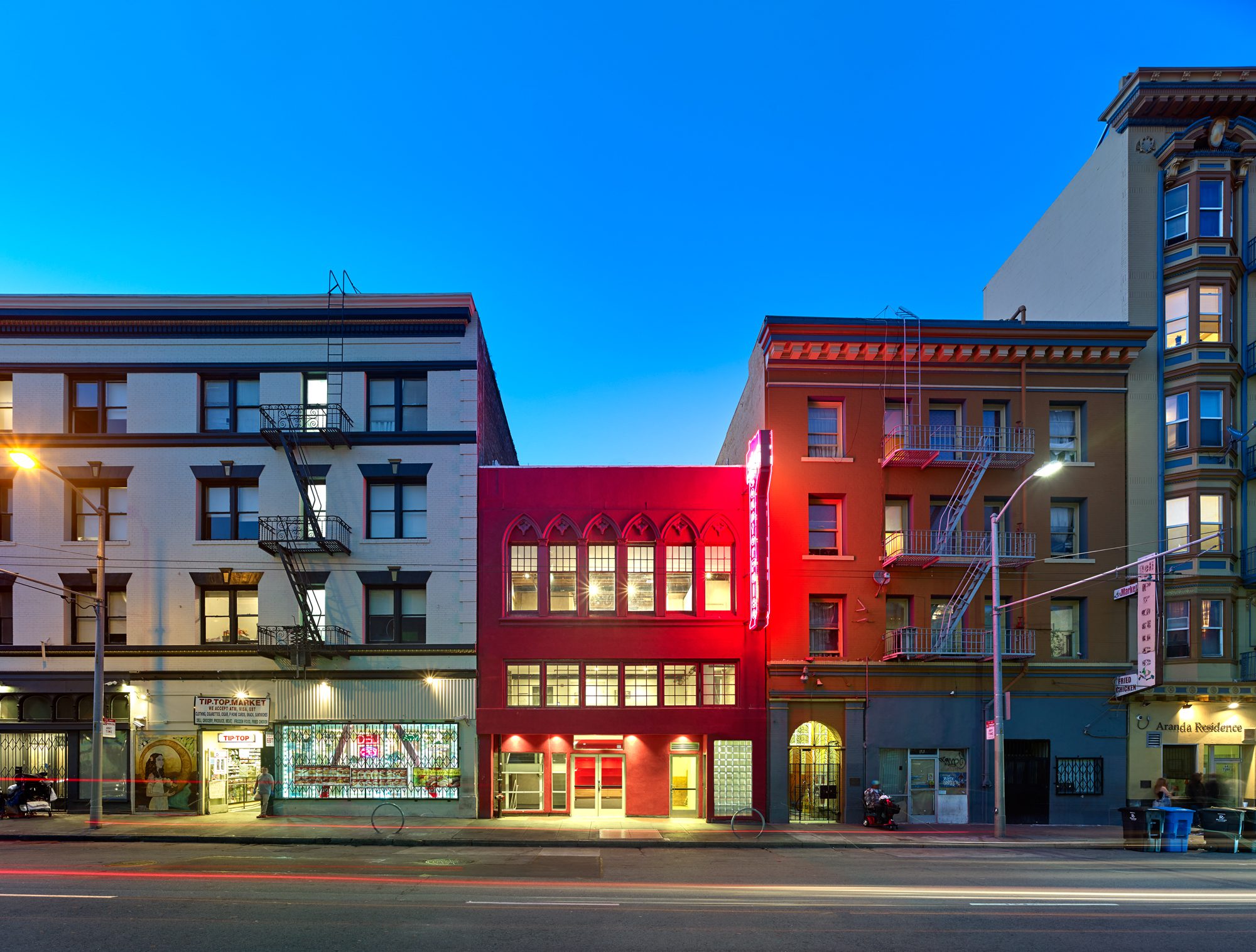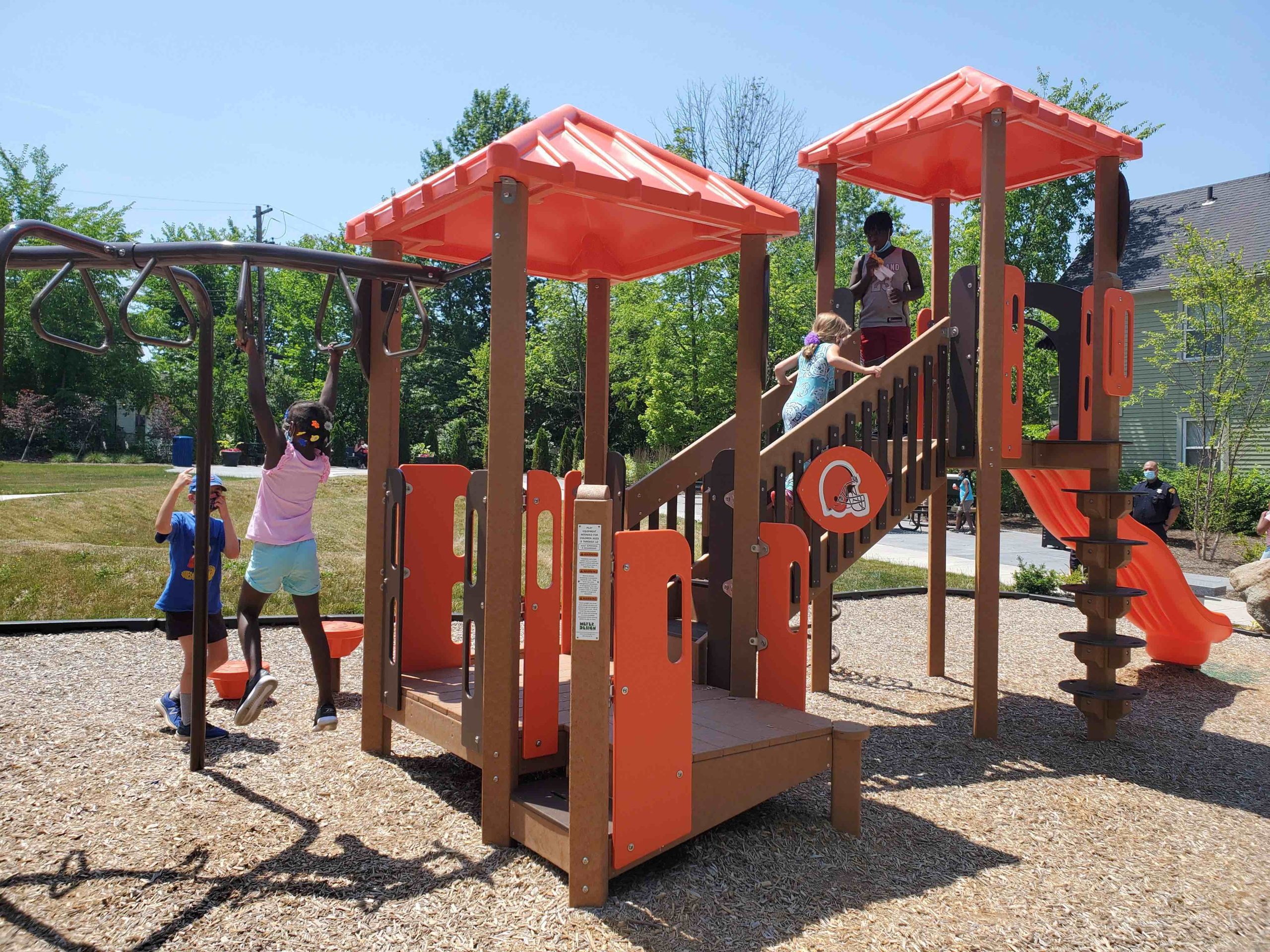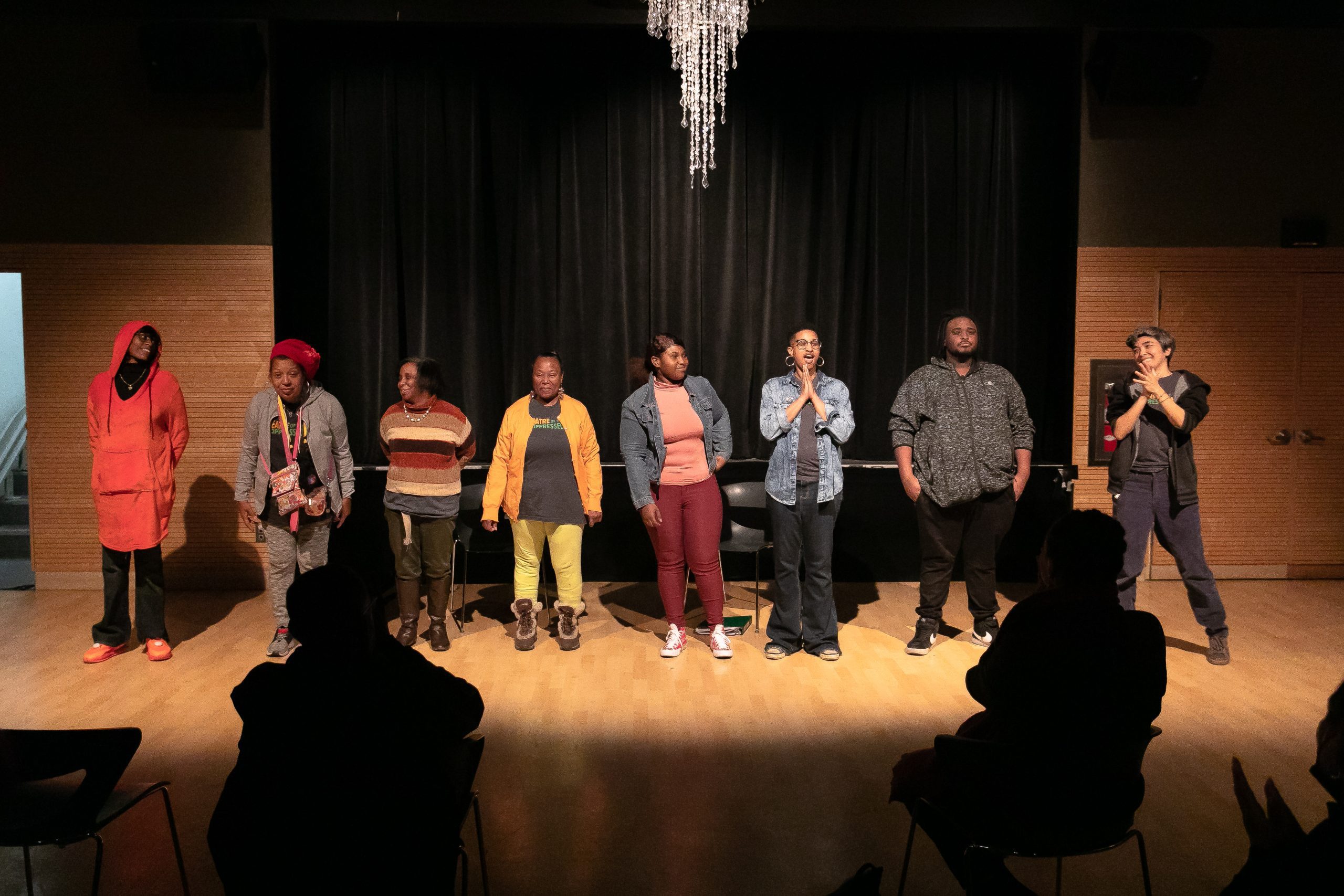
80 Turk St. Photo by Cesar Rubio
An underwater banquet hall. A stage for experimental dance. A nightclub for the disabled. A venue for immersive percussion.
In San Francisco, 80 Turk St. will take on all of these identities this spring as the home of experimental performing arts organization CounterPulse. Housed in a red building originally built in 1922 as a cabaret and later used as a pornographic movie theater, this storied structure in the city’s Tenderloin neighborhood started another chapter in February when CounterPulse finalized a purchase deal.
CounterPulse’s successful campaign to raise $7 million to buy and renovate the building is the culmination of a decade-long experiment to prove that philanthropy and the public sector can keep cultural venues alive in overheated real estate markets by purchasing properties and giving arts organizations sufficient runway to buy them back.
Now that CounterPulse is the 99 percent majority owner of 80 Turk St., backers can point to definite evidence that mission-driven real estate entities move the needle for a creative sector beset by escalating rents and property prices.
“CounterPulse’s success proves an important new model for how artists and community-based organizations can realistically afford to own their property given the right conditions—a combination of providing capital, technical assistance, and capacity building,” says Julie Phelps, executive director of CounterPulse.

Julie Phelps at 80 Turk St. Photo by Grey Tartaglione
“Mission-driven real estate entities can create those conditions now with confidence that organizations can step into them and succeed. By showing that the design works, we are the Rosetta Stone of the model.”
A Theater is Born
On a foggy day back in November 2013, Mayor Edwin Lee held a press conference in front of an art gallery, announcing that San Francisco would be the first city to embark on a mission-driven real estate venture for the arts. With $5 million pledged from the Kenneth Rainin Foundation and the Northern California Community Loan Fund (now Community Vision), alongside municipal grants, Lee launched the nonprofit Community Arts Stabilization Trust (CAST).
CAST would buy the art gallery, which was at risk of sale to private investors, and at the same time snap up 80 Turk St. for $1.3 million. This new real estate upstart was omnivorous in its approach to get hold of property that could become permanent space for arts and culture. It went on to lease a former streetcar mechanic shop and it received still another building as part of a community benefits agreement.
But CounterPulse was the linchpin of CAST’s model. Founded by an artist collective that merged with the Bay Area Center for Art & Technology, CounterPulse’s roots go back to the early 1990s. Its current name only dates to the early 2000s, when the organization rented space in the SoMa neighborhood for $1 per square foot with a small escalator clause for rent increases over a 10-year lease.
At the time, SoMa was a struggling light industrial district. In the wake of the Great Recession, San Francisco passed a payroll tax break in 2011, informally known as the “Twitter tax break,” that lured tech companies to the neighborhood. Twitter itself eventually built a new headquarters on the same block as CounterPulse’s rented digs in SoMa.
“We saw the writing on the wall,” says Phelps. “There’s the overall anxiety of being a renter amidst the volatility of San Francisco’s real estate market and not knowing how long you’re going to be able to stay. When lease renewals come up it’s an inflection point even when Twitter isn’t moving to your block.”
[RELATED ARTICLE: Buying Power—Why Nonprofits Should Own Their Space]
The landlord offered a so-called friends and family rate on a new lease once CounterPulse’s 10-year run in SoMa expired in February 2015. But it was still double the old rent, so Phelps declined to renew and instead approached Northern California Community Loan Fund (now Community Vision) for relocation advice. The fund helped CounterPulse prepare a facility strategic plan to figure out what kind of space it could afford.
CounterPulse’s timing was propitious: The Kenneth Rainin Foundation, a family foundation with a large arts philanthropy portfolio, was watching San Francisco’s mid-2010s tech boom with trepidation. They feared a repeat of the dot-com boom a decade prior that had proven devastating for the City by the Bay’s fragile arts ecosystem.
“What lessons were learned from the dot com displacement crisis that would safeguard arts organizations against the speculative real estate market for the long term?” Chief Program Officer Shelley Trott recalls the foundation thinking at the time.
One answer: Put buildings in trust for the arts, no different from how the affordable housing and agriculture sectors approach development pressures.
In January 2013, a representative from the loan fund took Phelps to see 80 Turk St. The fund intended to compete with an all-cash offer and was shopping around for the right arts organization to take over the space, smack dab in what Phelps calls “the beating heart of the vice neighborhood of the Tenderloin.” The theater was at the intersection of Turk and Taylor, which had a reputation as a nexus of gun violence, drug dealing, gang activity, and prostitution.
But intrepid CounterPulse was willing to take a chance on moving from SoMa to the Tenderloin—and see past some of the neighborhood’s grittier aspects to engage with its tight-knit residential population. That gamble has paid off to the neighborhood’s benefit. Over a decade, CounterPulse’s TenderArts program has painted a mural, organized drumming circles, created a lending library, and hosted twice monthly arts and crafts workshops.
Before moving into its new digs, however, CounterPulse had to convince the owner to sell to CAST. He had rejected the all-cash buyer competing with the loan fund. He acquiesced on May 3, 2013, after attending the organization’s annual benefit and seeing performances from the likes of choreographer Keith Hennessy and Axis Dance Company. In short, the transaction was about more than just negotiating the right price–the property owner was motivated to sell because the building was destined to be used creatively.
“There is a unique ability of the arts to catalyze these projects,” says Phelps. “People in cities like San Francisco, London, and Seattle want to see art happen. They are creative cities and almost everyone has some place in their heart for the arts.”

Ivy Monteiro in “Mother: The Verb,” 2017. Photo by Robbie Sweeny
Show Time
CounterPulse began running pop-up programming soon after the purchase was finalized, both to acquaint themselves with the neighborhood and feel out what renovations were needed to transform the old building into a state-of-the-art performance space. Meanwhile, they began working with CAST to formulate a structure for this new venture. What legal vehicle made the most sense for CounterPulse to grow into the role of building owner?
The answer was an entity called CAST 80 Turk LLC, incorporated in October 2014. Under the LLC’s operating agreement, CAST held a 90 percent stake as the managing member owner and CounterPulse held a 10 percent stake as the tenant member owner. CounterPulse began paying 51 cents per square foot in monthly rent to CAST in 2016, a rate that escalated to 59 cents per square foot by 2022. At nearly half what CounterPulse had paid in rent per square foot on a lease signed a decade prior, the rent was significantly below market rate.
Since both owners are nonprofits, CAST 80 Turk LLC received a welfare tax exemption on its property taxes. However, CAST believes this sweetheart deal was sweeter than necessary. “One of the lessons learned for future projects is that the rent should be slightly higher, yet still affordable and below market rate for our arts partner, to be able to cover the operating costs of the LLC more sufficiently,” says outgoing CAST CEO Moy Eng.
The full cost of the land purchase, renovations, and CAST developer and project management fees totaled $5.6 million. Early in the process, CounterPulse came up with $1.3 million as an initial tenant contribution toward that sum. The arts organization also secured $1.4 million in 2015 via the New Market Tax Credit to finance the renovations. On Feb. 4, 2015, CAST 80 Turk LLC formally acquired the building as part of the tax credit transaction. For the first time, CounterPulse had a legal equity stake in the building. Now the clock began ticking.
Accepting the tax credit established a minimum seven-year timeline before CounterPulse could buy out a majority stake in CAST 80 Turk LLC. If CounterPulse were not able to buy out CAST after seven years, they would have received two lease extensions totaling eight years. And if CounterPulse had chosen to vacate 80 Turk St., then CAST would have helped them relocate—while holding onto the site for a future arts organization.
But CounterPulse wanted to make 80 Turk St. their forever home. To accomplish that goal, all said and done, CounterPulse had to raise a sum total of $7 million through grants, donations, and subsidies.
At the time, Phelps was 29 and running an experimental dance theater in a rented 3,800-square-foot building with an $800,000 annual budget. Prior to embarking on the quest to purchase 80 Turk St., CounterPulse’s fundraising ambitions were modest: an annual gala raised around $15,000; mailers netted another $15,000. Now Phelps had to spearhead what eventually became a $7 million fundraising campaign.
“It was totally daunting,” she says.
But CounterPulse wasn’t left to the wolves. CAST’s model also intended to build the capacity of the recipient organization. They coached Phelps’ fundraising pitch, homing in on the fact that donations would have a second life at the completion of the fundraising campaign. Once CounterPulse repaid CAST, then CAST could go on to acquire more properties for other arts organizations.
“We went from ‘if you care about experimental contemporary dance’ to ‘if you care about the place of the arts in San Francisco,’ then give to CounterPulse,” Phelps says. “It’s a gift that keeps on giving. That was a compelling pitch.”
Not that there weren’t discouragements. Experimental dance and the Tenderloin still left some donors skeptical. “I had to characterize my fundraising years by how many noes I got versus how many yeses I got,” she says.
But early donations, like $500,000 from the Hewlett Foundation, generated momentum that carried through the campaign right up until the Kenneth Rainin Foundation came full circle in December 2021 with $500,000 to help CounterPulse meet a key benchmark. The Zellerbach Family Foundation also donated $75,000 and invited CounterPulse to be the first beneficiary of a new zero-interest lending model for another $500,000, the final chunk to allow CounterPulse to complete the purchase.
Phelps sums up CounterPulse’s success as “luck and hard work.”
“We hit the stride on a lot of philanthropic program areas,” she says.
Cause and Solution
While CAST has rolled out a variety of arrangements to carve out affordable space for artists and arts organizations, what CounterPulse accomplished holds special significance. “CounterPulse is the culmination of CAST’s original vision: a successful completion of a lease-to-own model with a contemporary arts organization,” says Eng.
While Eng would not disclose where CAST will invest next with the repaid funds, she says that CAST is in talks with 13 Bay Area arts organizations. This optimism is also evidence that CounterPulse was not a one-off. There are other mid-sized arts organizations with scope to grow into the responsibility of buying their own building.
“Their success offers us hope that this is a model that can be replicated at scale,” says Eng. “It proves that even with a highly complex problem like artist displacement, we can find a solution when there is collaboration across private and public sectors and motivated leadership.”
With the flagship success of CounterPulse, the nascent network of mission-driven real estate holding entities for culture are emboldened. Seattle’s quasi-public Cultural Space Agency launched in 2021 and acquired its first properties less than a year ago. It organizes a 20-person yearlong cohort that meets monthly to explore the intersection of art and commercial real estate and it maintains a 50-person internal advisory group of cultural space leaders, commercial lenders, architects, developers, and city planners.
The Cultural Space Agency is a minority partner that manages buildings for its partner organizations, which run entities like a tap dance studio, a community radio station and an art gallery. While the agency is constructed in a similar vein to CAST, its interim director Matthew Richter doesn’t see organizations buying back their buildings as the inevitable goal of any given partnership.
“Buying us out is a bonus, which means they have grown,” says Richter. “The ability to reinvest that capital is great but it’s not critical for us.”
In an affluent metropolitan area like greater Seattle, Richter believes, there are always additional philanthropic dollars. “Seattle has three space exploration companies—the presence of resources is not the issue,” he says. “It’s the scale of the challenge and opportunity that excites those resources.”
Phelps shares the sense that wealth is both the cause of and solution to the artist displacement dilemma. “Cities like San Francisco are the only place it’s going to happen because the capital is here,” she says.
For CAST’s counterparts in other hot real estate markets, CounterPulse’s success is motivation. “This is the validation of a decade of vision and it is going to put the next decade’s worth of fuel into the tank for continuing to pursue the vision,” Richter says.
This story was published through a collaboration with Shelterforce and Next City. Next City is a nonprofit news outlet that publishes solutions to the problems that oppress people in cities, inspiring social, economic, and environmental change through journalism and events around the world.






Comments